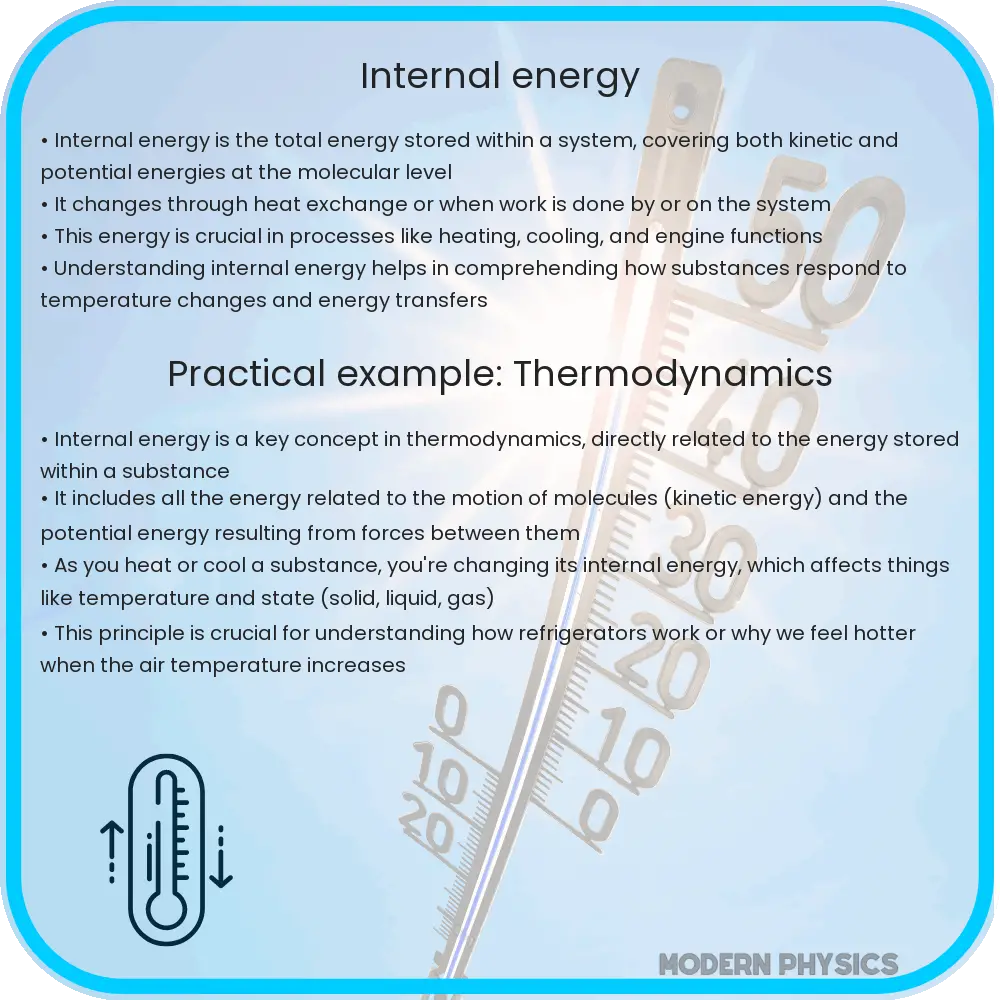Explore the essentials of internal energy in thermodynamics, its conservation, system types, applications, and role in phase transitions.

Understanding Internal Energy in Thermodynamics
Internal energy is a fundamental concept in thermodynamics, an area of physics that deals with heat and temperature and their relation to energy and work. It represents the total energy stored within a system and is composed of the kinetic and potential energy of its particles.
The Basics of Internal Energy
In thermodynamics, internal energy is denoted by the symbol U and is a state function. This means that its value depends only on the current state of the system, not on how that state was achieved. The internal energy of a system can change through heat transfer, work done on or by the system, and mass transfer.
Conservation of Internal Energy
The law of conservation of energy states that energy cannot be created or destroyed, only transformed or transferred. In a closed system, where no mass is transferred in or out, the change in internal energy (∆U) is equal to the heat added to the system (Q) minus the work done by the system (W), expressed as:
∆U = Q – W
For an isolated system, where neither mass nor energy is exchanged with the surroundings, the internal energy remains constant regardless of the processes occurring inside the system.
Systems in Thermodynamics
Thermodynamic systems are classified into three main types:
- Open Systems: These systems can exchange both energy and matter with their surroundings. Examples include boiling water in an open pot.
- Closed Systems: These systems exchange energy but not matter with their surroundings. An example is a sealed, heated container.
- Isolated Systems: These systems do not exchange energy or matter with their surroundings. An ideal isolated system is theoretical, as perfect isolation is practically impossible.
Understanding the type of system is crucial in analyzing and applying the concept of internal energy, as it dictates the possible interactions with the surroundings and influences the system’s energy changes.
Practical Applications of Internal Energy
Internal energy plays a crucial role in various practical applications. For instance, in the design of heat engines, such as in automobiles, the conversion of internal energy into mechanical work is a key process. Similarly, in refrigeration, internal energy is manipulated to transfer heat from a cooler area to a warmer one, contrary to natural heat flow.
Measuring Internal Energy
Direct measurement of internal energy is not feasible, as it includes all microscopic forms of energy within a system. However, changes in internal energy can be inferred through measurable quantities like temperature, pressure, and volume. For instance, in an ideal gas, the internal energy change is directly proportional to the temperature change, following the formula:
∆U = nCv∆T
Where n is the amount of substance, Cv is the molar specific heat at constant volume, and ∆T is the temperature change.
Role of Internal Energy in Phase Transitions
Phase transitions, such as melting or vaporization, involve significant changes in internal energy without altering the temperature. During these processes, energy is absorbed or released, primarily affecting the potential energy of particles and leading to a change in phase.
For example, the energy required to change water from liquid to gas at its boiling point is known as the heat of vaporization and represents a significant increase in internal energy without a temperature change.
Conclusion
Internal energy is a pivotal concept in understanding thermodynamic processes. It encompasses the total energy within a system and is subject to the laws of energy conservation. While internal energy itself is not directly measurable, its changes have profound implications in practical applications like heat engines and refrigeration systems. Additionally, the role of internal energy in phase transitions further highlights its importance in both natural and engineered processes. By grasping the fundamentals of internal energy, we gain insight into the invisible yet powerful forces that govern the behavior of matter in our universe.
